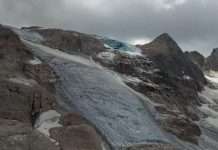POTSDAM, Germany, Aug. 17 (Brooks Hays) — The glaciers of Central Asia, which supply clean water to billions, are shrinking.
According to a new study, the ice sheets of Central Asia’s largest mountain range, Tien Shan, have lost 27 percent of their mass and 18 percent of their surface area over the last half-century. A team of researchers from France and Germany suggest half the region’s glaciers could be gone by 2050.
The health of Tien Shan’s ice reserves are vital for Kazakhstan, Kyrgyzstan, Uzbekistan, and parts of China, which rely on the glacier meltwater to supply their population with clean water.
Despite the region’s importance, Tien Shan’s glaciers haven’t been closely monitored in recent decades. Researchers have attempted to account for the lack of information by reconstructing the evolution of Central Asian glaciers.
“We combined various methods based on satellite gravimetry, laser altimetry and glaciological modeling,” lead study author Daniel Farinotti, researcher at GFZ German Research Centre for Geosciences, explained in a press release.
“This way, we were able to reconstruct the evolution of every single glacier,” Farinotti added. “Currently, the Tien Shan is losing ice at a pace that is roughly twice the annual water consumption of entire Germany.”
The new research was published in the journal Nature Geoscience.
Meltwater is especially important for regions with long dry seasons. Glaciers serve as bank in which precipitation can be stored for later use. This is Central Asia’s model for local water supply, and one under increasing climatic pressure.
With temperatures rising, Central Asia’s glaciers are relinquishing more and more meltwater during the hot months. And they’re also failing to replenish themselves.
“Since the winter months in the region are very dry and the mountains are that high, glaciers receive most of their snowfalls during summer,” Farinotti said. “This means that an increased temperature contributes to both increased melt and reduced glacier nourishment — and obviously, both contribute to glacier wastage.”
A diminished water supply could have negative effects on China’s northwestern Xinjiang Uyghur autonomous region. The area’s coal, oil and gas industries are an important part of the Chinese economy.
“If water resources really will decline there in the future, there is a big potential for conflicts,” Farinotti told Live Science.






